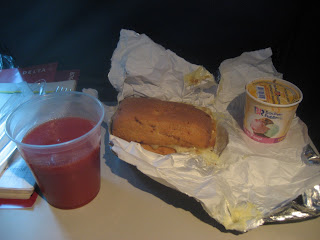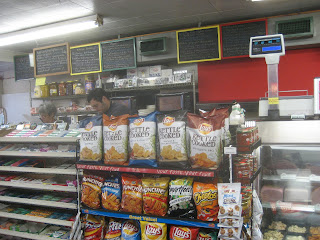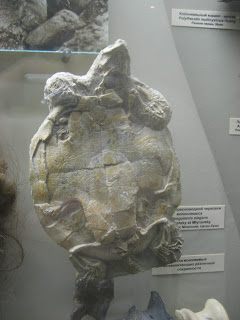I taught my last class on a Wednesday and my flight out of Moscow was the next day at noon. After the final class I had dinner with ''Vasya'' and here is what my last supper was:
Although I got picked up at the airport by a taxi when I arrived in Moscow, I did not want to take a taxi to go back to the airport when I left, since I still remembered the terrible traffic problems I had in the taxi on the first day because of one road accident. It used to be the case that the only way to reach the airport from elsewhere in Moscow was by a road vehicle, either a taxi or one of the airport vans at the Rechnoi Vokzal metro station. Either way, if I got caught in bad traffic I could miss my flight.
Fortunately two years ago an alternative form of transportation to and from the airport appeared: Aeroexpress. It is a train that goes between Sheremetyevo airport and the Belorusskaya train station for 300 rubles, which is about $5. (There is similar train service on Aeroexpress to other Moscow airports.) The train ride to Sheremetyevo takes 35 minutes and is much more reliable than a car since it won't have any traffic problems. Of course you still have to get to the Aeroexpress train, and with large suitcases it may be easier to get to that train station by car or taxi than by taking the metro. (Note: if you bring a very large suitcase on the metro you have to pay an additional fee to use the metro.) I wound up having a friend with a car drive me to the Aeroexpress early in the morning and there was no traffic at all. There might not even have been any traffic all the way to the airport at that hour, but why introduce more risk of getting caught behind a car accident?
Here is the Aeroexpress train at the departure point in Belorusskaya station:
You can pay for the ticket by standing in line, but you can also buy it from an electronic ticket machine, and some of the machines indicate that they give exact change. However, it's easy enough to carry 300 rubles that it shouldn't be necessary to make sure the particular machine you use gives exact change. I used a ticket machine and avoided the ticket line.
Thirty-five minutes after the train left Belorusskaya station, it arrived at the airport:
Terminal F is the same thing as what used to be called Sheremetyevo-2, which is where international flights at Sheremetyevo are located. Here is the Aeroexpress train at the airport:
There are two levels of service: economy class (300 rubles) and business class (500 rubles). The difference between those prices is about 6 1/2 US dollars. What are the extra features of business class? Let's take a look. First let's see what economy class looks like:
You can see above the seats in economy class. There are overhead bins to put luggage, but the aisles between the two sides was wide enough that a lot of people just left their luggage in the aisle.
Now let's see how business class looks:
So business class has exactly the same seats as economy class, but they come with an extra white cloth. In the middle of the business class car were bottled water and newspapers:
Of course nothing stops economy class travelers from bringing their own water and newspaper. And with a piece of white cloth you can duplicate the entire amazing business class experience. Since the whole ride take a little over half an hour, I can't figure out why anybody would bother with business class.
Once I got through security and luggage check-in, I could see my plane at the gate:
From my seat on the plane I could see the snowy airport tarmac on the outside
and important airline flight information on the inside, like a map.
Shortly before takeoff we were reminded to put on our seat belts. More precisely, we were told that the plane could not take off without all of us having our seat belts on. Oh really? Do the airline engines run on seat belt power? The plane was barely half full, so would our seat belts generate enough thrust to take off?
After we somehow managed to take off with so many unused seats, and unused seat belts, it turned out to be very cold outside the plane, in both Fahrenheit and Celsius:
It was a long flight. There were four movies shown and there were two meals served, one at the start of the flight
and the other near the end:
The sandwich you see there was very hot to touch when the stewardess gave it to me, and I told her that. She said it really wasn't that hot, but then I heard her tell the passengers behind me "Be careful, it's hot" when she gave them the sandwich. The Russian-made Baskin Robbins ice cream on the right has a slogan along the bottom of the container: мороженое, которое любит весь мир. Read from left to right, that says "ice cream, which loves the whole world", but Russian word order is more flexible than English, so you can guess what a better translation is supposed to be.
As the plane approached New York, I saw another plane coming in to land at the airport:
Finally we landed
and at that point I turned on my cell phone to tell family members I was on the ground. Although the phone had been shut off for 2 1/2 months, it still worked, but it was at Low Battery level. Later that day I arrived at my dad's house:
The next day I went up to Connecticut by train. The Long Island Railroad arrives in New York at Penn Station, where I found someone looking at a subway map:
This didn't look quite as nice as the religious guy looking at the metro map in Moscow. And the New York subway platforms are a lot less elegant than those in Moscow:
The trains in New York leave for Connecticut from Grand Central Terminal, not Penn Station, so I took a subway from Penn Station up to Times Square, where I caught the cross-town shuttle train to Grand Central:
Unlike Penn Station, Grand Central Terminal is actually attractive on the inside:
My train here was located just slightly underground, but it was enough for the cell phone to have trouble working:
In Moscow, by comparison, cell phones worked in all metro stations even though they can be located very deep underground. New York should learn a lesson from that.
Although many tourists were taking photos inside Grand Central Terminal, when I took photos near the train one of the train staff told me it is not allowed.
The train has reminders about avoiding slipping on the gap between the train and the platform.
The gap is hardly as large as the one pictures in the diagram. But if they're so concerned about people slipping they should also post warning signs about slipping on spilled coffee:
You can see the person who spilled the coffee through the window in the next photo (look on the left):
He was quick to throw away his coffee cup. A few minutes later one of the train staff came walking through the train, saw the spill, and immediately called several of her colleagues about it. They cleaned it up while hypothesizing when it could have happened. The coffee spiller just kept quiet the whole time while sitting right next to the scene of the crime.
The train should have had a warning sign in the bathroom, since their "Keep Clean" sign in the bathroom was not working:
I took this train to New Haven, where my friend Dave picked me up and we went to his office at Wesleyan for a few hours. Nearby we bought sandwiches at the Neon Deli:
Why is it called the Neon Deli? They used to have a neon sign out front with the word "Deli" on it. At one point the sign was broken, so they switched to the plastic signs you see above. Would anyone consider buying food at the Plastic Deli?
Here are two of the staff making sandwiches inside, with the menu behind them on small blackboards:
Dave ordered the same sandwich there so many times that they named it after him. Look on the right board below for ''Dave's toasty turkey, provolone, and hots (that is, peppers).''
I had no interest in peppers, so I asked the staff to replace the peppers with tomatoes (tvorog wasn't really an option). In a sense that makes the sandwich something Dave would never actually order, because he hates uncooked tomatoes.
While preparing this blog entry I found out that the free storage space on my Picasa web album is nearly full (I had to delete a few earlier photos to fit everything in). A new blog about my visit to Berkeley for the next semester is here.
Although I got picked up at the airport by a taxi when I arrived in Moscow, I did not want to take a taxi to go back to the airport when I left, since I still remembered the terrible traffic problems I had in the taxi on the first day because of one road accident. It used to be the case that the only way to reach the airport from elsewhere in Moscow was by a road vehicle, either a taxi or one of the airport vans at the Rechnoi Vokzal metro station. Either way, if I got caught in bad traffic I could miss my flight.
Fortunately two years ago an alternative form of transportation to and from the airport appeared: Aeroexpress. It is a train that goes between Sheremetyevo airport and the Belorusskaya train station for 300 rubles, which is about $5. (There is similar train service on Aeroexpress to other Moscow airports.) The train ride to Sheremetyevo takes 35 minutes and is much more reliable than a car since it won't have any traffic problems. Of course you still have to get to the Aeroexpress train, and with large suitcases it may be easier to get to that train station by car or taxi than by taking the metro. (Note: if you bring a very large suitcase on the metro you have to pay an additional fee to use the metro.) I wound up having a friend with a car drive me to the Aeroexpress early in the morning and there was no traffic at all. There might not even have been any traffic all the way to the airport at that hour, but why introduce more risk of getting caught behind a car accident?
Here is the Aeroexpress train at the departure point in Belorusskaya station:
You can pay for the ticket by standing in line, but you can also buy it from an electronic ticket machine, and some of the machines indicate that they give exact change. However, it's easy enough to carry 300 rubles that it shouldn't be necessary to make sure the particular machine you use gives exact change. I used a ticket machine and avoided the ticket line.
Thirty-five minutes after the train left Belorusskaya station, it arrived at the airport:
Terminal F is the same thing as what used to be called Sheremetyevo-2, which is where international flights at Sheremetyevo are located. Here is the Aeroexpress train at the airport:
There are two levels of service: economy class (300 rubles) and business class (500 rubles). The difference between those prices is about 6 1/2 US dollars. What are the extra features of business class? Let's take a look. First let's see what economy class looks like:
You can see above the seats in economy class. There are overhead bins to put luggage, but the aisles between the two sides was wide enough that a lot of people just left their luggage in the aisle.
Now let's see how business class looks:
So business class has exactly the same seats as economy class, but they come with an extra white cloth. In the middle of the business class car were bottled water and newspapers:
Of course nothing stops economy class travelers from bringing their own water and newspaper. And with a piece of white cloth you can duplicate the entire amazing business class experience. Since the whole ride take a little over half an hour, I can't figure out why anybody would bother with business class.
Once I got through security and luggage check-in, I could see my plane at the gate:
From my seat on the plane I could see the snowy airport tarmac on the outside
and important airline flight information on the inside, like a map.
Shortly before takeoff we were reminded to put on our seat belts. More precisely, we were told that the plane could not take off without all of us having our seat belts on. Oh really? Do the airline engines run on seat belt power? The plane was barely half full, so would our seat belts generate enough thrust to take off?
After we somehow managed to take off with so many unused seats, and unused seat belts, it turned out to be very cold outside the plane, in both Fahrenheit and Celsius:
It was a long flight. There were four movies shown and there were two meals served, one at the start of the flight
The sandwich you see there was very hot to touch when the stewardess gave it to me, and I told her that. She said it really wasn't that hot, but then I heard her tell the passengers behind me "Be careful, it's hot" when she gave them the sandwich. The Russian-made Baskin Robbins ice cream on the right has a slogan along the bottom of the container: мороженое, которое любит весь мир. Read from left to right, that says "ice cream, which loves the whole world", but Russian word order is more flexible than English, so you can guess what a better translation is supposed to be.
As the plane approached New York, I saw another plane coming in to land at the airport:
and at that point I turned on my cell phone to tell family members I was on the ground. Although the phone had been shut off for 2 1/2 months, it still worked, but it was at Low Battery level. Later that day I arrived at my dad's house:
The next day I went up to Connecticut by train. The Long Island Railroad arrives in New York at Penn Station, where I found someone looking at a subway map:
This didn't look quite as nice as the religious guy looking at the metro map in Moscow. And the New York subway platforms are a lot less elegant than those in Moscow:
The trains in New York leave for Connecticut from Grand Central Terminal, not Penn Station, so I took a subway from Penn Station up to Times Square, where I caught the cross-town shuttle train to Grand Central:
Unlike Penn Station, Grand Central Terminal is actually attractive on the inside:
My train here was located just slightly underground, but it was enough for the cell phone to have trouble working:
In Moscow, by comparison, cell phones worked in all metro stations even though they can be located very deep underground. New York should learn a lesson from that.
Although many tourists were taking photos inside Grand Central Terminal, when I took photos near the train one of the train staff told me it is not allowed.
The train has reminders about avoiding slipping on the gap between the train and the platform.
The gap is hardly as large as the one pictures in the diagram. But if they're so concerned about people slipping they should also post warning signs about slipping on spilled coffee:
You can see the person who spilled the coffee through the window in the next photo (look on the left):
He was quick to throw away his coffee cup. A few minutes later one of the train staff came walking through the train, saw the spill, and immediately called several of her colleagues about it. They cleaned it up while hypothesizing when it could have happened. The coffee spiller just kept quiet the whole time while sitting right next to the scene of the crime.
The train should have had a warning sign in the bathroom, since their "Keep Clean" sign in the bathroom was not working:
I took this train to New Haven, where my friend Dave picked me up and we went to his office at Wesleyan for a few hours. Nearby we bought sandwiches at the Neon Deli:
Why is it called the Neon Deli? They used to have a neon sign out front with the word "Deli" on it. At one point the sign was broken, so they switched to the plastic signs you see above. Would anyone consider buying food at the Plastic Deli?
Here are two of the staff making sandwiches inside, with the menu behind them on small blackboards:
I had no interest in peppers, so I asked the staff to replace the peppers with tomatoes (tvorog wasn't really an option). In a sense that makes the sandwich something Dave would never actually order, because he hates uncooked tomatoes.
While preparing this blog entry I found out that the free storage space on my Picasa web album is nearly full (I had to delete a few earlier photos to fit everything in). A new blog about my visit to Berkeley for the next semester is here.





































































































